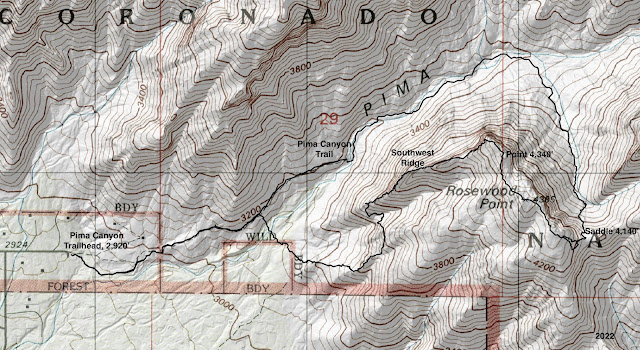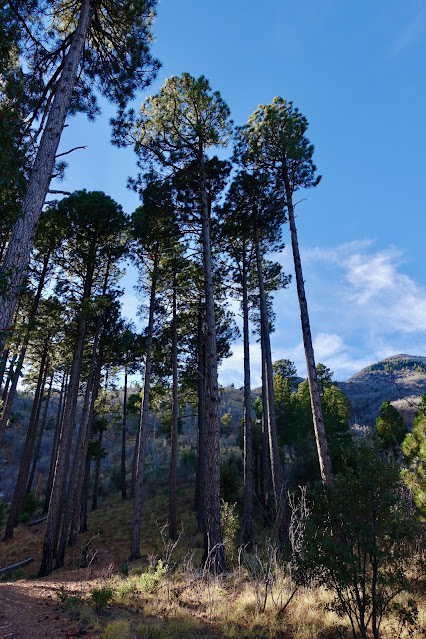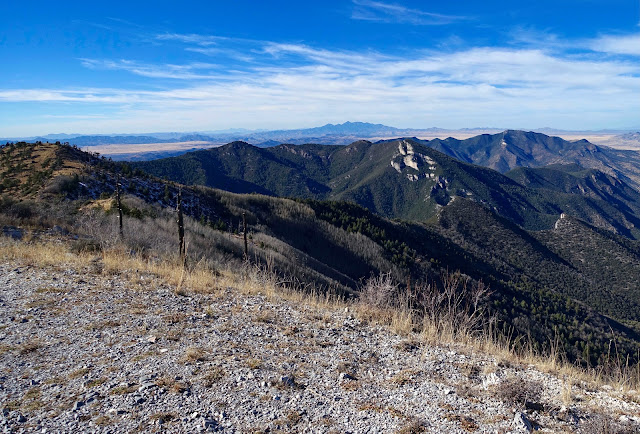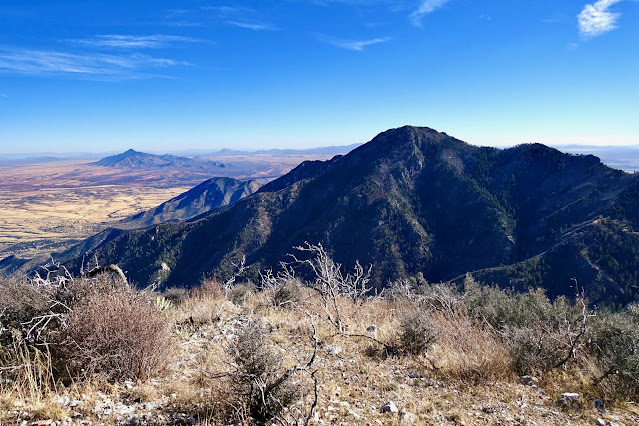Essence: Rosewood Point is a small, unranked promontory on the south wall at the mouth of Pima Canyon. It is in the foreground of the Catalina Front and highly visible from town. This short but rugged off-trail loop takes the standard route to the peak and descends on the southwest ridge. Once the hike leaves the Pima Canyon Trail there are no cairns or footprints--in other words, no assistance. Views of the Pima Canyon headwall are spectacular from the summit. The hike is within the Pusch Ridge Wilderness managed by the Coronado National Forest.
Travel: From Tucson, drive north on Oracle Road, AZ-77. Pass Ina Road and turn right on Magee Road. Go 1.5 miles to the Iris O. Dewhirst Pima Canyon Trailhead. Or, from Ina Road take Christie Drive north for 1.4 miles and turn right on Magee. The generous, paved lot is on the right. There is a drinking faucet but no other facilities.
Distance and Elevation Gain: 5.1 miles; 1,800 feet
Total Time: 4:30 to 5:30
Difficulty: Trail, primarily off-trail; navigation challenging; Class 2+; considerable exposure on the precipice can be managed; brushy, wear long pants; carry all the water you will need and hike on a cool day.
Map: Tucson North, AZ 7.5' USGS Quad
Latest Date Hiked: December 11, 2021
Travel: From Tucson, drive north on Oracle Road, AZ-77. Pass Ina Road and turn right on Magee Road. Go 1.5 miles to the Iris O. Dewhirst Pima Canyon Trailhead. Or, from Ina Road take Christie Drive north for 1.4 miles and turn right on Magee. The generous, paved lot is on the right. There is a drinking faucet but no other facilities.
Distance and Elevation Gain: 5.1 miles; 1,800 feet
Total Time: 4:30 to 5:30
Difficulty: Trail, primarily off-trail; navigation challenging; Class 2+; considerable exposure on the precipice can be managed; brushy, wear long pants; carry all the water you will need and hike on a cool day.
Map: Tucson North, AZ 7.5' USGS Quad
Latest Date Hiked: December 11, 2021
Pusch Ridge Wilderness Bighorn Sheep Closure: It is prohibited to
travel more than 400 feet off designated Forest Service trails from
January 1 through April 30, bighorn sheep lambing season. Rosewood Point is off-limits during that period. No dogs, ever.
Quote: The best runner leaves no tracks. Lao Tzu, Tao Te Ching
Quote: The best runner leaves no tracks. Lao Tzu, Tao Te Ching
Rosewood Point is just a little hill sitting out in front of the mighty peaks of the Santa Catalina Mountains. However, the hike has the allure of a granite block summit and an airy ridge descent back into the Pima Canyon runout zone. This image was taken from the southern slope of Bighorn Mountain. (Thomas Holt Ward, photo)
Route: Hike for almost two miles northeast on the Pima Canyon Trail. Leave the trail and ascend in the wash bed of a south fork of Pima. When the tributary turns northeast, leave it and pitch south to Saddle 4,140'. Climb northwest to Rosewood Point and Point 4,340'. Descend on the southwest ridge. Leave the ridge at a gendarme at 3,540 feet. Bypass a pouroff, working south and then west back to the Pima Canyon Trail.
From the Iris O. Dewhirst Pima Canyon Trailhead, elevation 2,920 feet, walk through private land on a thin easement. This treadway has been described numerous times in Earthline. It is the service trail for Prominent Point West, The Cleaver, Bighorn and Table mountains, Table Tower, and Mount Kimball. Besides being of essential use as an access corridor into the Pusch Ridge Wilderness, the rugged footpath is exquisitely beautiful. Mount up on bedrock slopes, ramps, and stone steps as you pass through a Sonoran arboretum with typical congregants: ocotillo, saguaro, agave, staghorn cholla, sotol, and prickly pear. If you do this hike in the spring, wildflowers paint the entire canvas with lavish color. At 0.4 mile, turn left on Trail No. 62, following the sign for Kimball "Peak," seven miles distant.
At half a mile, the Pima Canyon cristate lives on a slope about 100 feet above the trail.
As the path curves into the canyon, walls gather in. The southwest ridge of Rosewood is upcanyon right, pictured below along with the pouroff and bypass route.
Cross the Pima Canyon wash at 1.1 miles. Surface flow is intermittent but in December there was a slip of water following heavy rain. The earth was moist and triangleleaf bursage grew amongst the cottonwoods. These shrubs look inconspicuous but their characteristic perfume gives them away. Point 4,340' is the hatchet-edged pivot point at the junction of two canyons.
The route up Rosewood leaves the Pima Canyon Trail at the south fork crossing. This critical juncture is a little over 1.8 miles from the trailhead and across from The Cleaver.
Prior to 2021, the standard cairned route left the trail in another tenth of a mile because the entrance to the waterway was choked with vegetation. The Bighorn Fire in 2020 and heavy monsoons during the summer of 2021 altered the landscape. The old route is now obliterated by heavy brush. The floods blew out the drainageway and it is now much
faster and more accommodating than the previous route.
Just step up the drainage on the stone staircase. The granite walls of Rosewood Point will be on your right. Saddle 4,140' is image-center.
At 2.4 miles, about 3,860 feet, the south fork makes a 90 degree turn to the northeast at a 15-foot barrier wall, shown. The route to Prominent Point West climbs the wall, staying with the drainage. Our route leaves the wash and makes for the saddle between Rosewood and Point 5,173'. (THW, photo)
Bust south up to the saddle. Either climb the rock runners or the slope to their right. The short line of cliffs part way up the incline is easy to dodge. Morning glory, a tangle foot, trip-wire plant was somewhat annoying. It was not present in 2015.
Gain the saddle at 2.6 miles. There is a grand-sweep view of Tucson and the ranges off to the south. Some of you will be temped by the prominence northeast of the saddle, Point 5,173', shown. My partner climbed it previously and reported a series of Class 3+ cliffbands. The terrain is loose, exposed, and brushy. (THW, photo)
From the saddle, Rosewood lies to the northwest, beyond a small wall. By far, the easiest and most enjoyable tactic is to do the low Class 3 climb right up through the cliffs. However, if you prefer not to scramble, you can scoot around the wall on the southwest side. It's a bit of a thorny, narrow squeeze. If you do the bypass, return to the ridge at first opportunity. Both routes are shown on the map above.
The ridgetop ascent is pleasant through boulders and grass. The Bighorn Fire scorched shindaggers, teddybear cholla, ocotillo, sotol, and yucca. Some of the saguaro survived. Below, the Rosewood summit is the rounded rise, 285 vertical feet from the saddle, 2.9 miles. The crest was once crowned by a paloverde tree, now sadly burned. The peak register is also missing.
And still, this lovely lookout with its far flung views enchants. The perspective on the peaks framing Pima Canyon is unmatched. Below, over on the right is the massive ramp leading to the Tombstone, the distinctive monolith seen from Tucson. Prominent Point West is out of sight, to the right of the string of spires. Topping the headwall are the aptly named Wolf's Teeth. Table Tower is hidden by the back slope of Table Mountain.
Whether you intend to retrace your steps or exit via the southwest ridge, walk north 0.2 mile to Point 4,340' across lovely terrain--granite slabs and grasses. Across the canyon is Pusch Peak, the westernmost summit on Pusch Ridge, The Cleaver, and Bighorn Mountain.
The dramatic cornerstone has been cleaved by the erosive power of two canyons.
We were curious whether the tempting southwest ridge was a viable exit route. Our first descent in 2015 was an exploratory gamble. We have since learned that the Southern Arizona Hiking Club (SAHC) has been descending on the ridge for years. It is for sure-footed hikers who enjoy scrambling and have a tolerance for exposure. The precipitous cliff edge can be avoided most of the time but there are a few airy pinches. From Point 4,340' descend north another 0.1 mile, halting a comfortable distance from the edge. This image was shot from there looking down on the first of three rollers.
From the first flat there is an intimate look at the 500-foot vertical sheer wall of Point 4,340'. (THW, photo)
We picked our way down steadily. There are no stone obstacles, just a tangle of spiny plants. Below, is the second roller.
At about 3,900 feet the ridge steepens and progress slows. This section is great fun for scramblers.
At 3.7 miles, 3,540 feet, is a blade of stone, an obstacle that can't be defeated. You may walk out on the razorback to the tipping point. The following is a description of our bypass. The going got tough after we left the ridge, primarily because of vegetation challenges.
Note: In 2021, we ran into a woman on the trail who began hiking with SAHC in 1986. She has led multiple hikes down Rosewood's southwest ridge. When she got to the blade, she scaled down on the south side of
the gendarme through a "notch". Then she went down a steep slope to the Pima Canyon wash. She hasn't been on the route for 20
years so she doesn't know if it remains safe or viable. We will return to check it out.
Meanwhile, here's a description of our bypass. Bail to the south and get on a stone sidewalk.
It leads into a drainage with an impassible pouroff.
Walk east on the slope above the watercourse until you can cross it and climb another 100 feet to get above the sidewalls and other obstacles.
Hike south to a ridge leading to the valley floor, image-left. In 2021, bufflegrass was so thick we couldn't see our feet.
This image looks back at the exit route from the final knoll. From there, bear west aiming for the wash. Scramble down through a short cliff band.
We crossed Pima Canyon at 4.4 miles, 3,060 feet. Then we hauled straight up the stony slope to the trail to close the loop.



























































